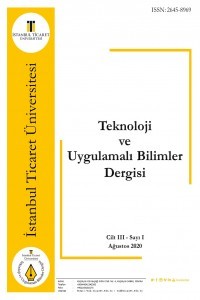An Adaptive Transceiver Design for Visible Light Communication
Wireless Visible light communication has been attracting many researchers attention recently the reasons are that visible light communication have some advantages which do not exist in radio frequency communications. Many researches done in visible light communication fields the most of these researches focused on how to achieve higher communication data rates and much less focused on the designing steps of the visible light communication transceiver to be utilized for indoor applications within short ranges. In this thesis designing and implementing of a visible light communication transceiver is successfully accomplished. The designed system composed of two main sections the transmitter section and the receiver section. The system uses two ATmega328P chip microcontrollers. Light emitting diodes used at the transmitter section as the transmitting module. The light emitting diode illumination light wave acts as the carrier of the transmitted signals. At the receiver section a photo detector and an LCD display are used to realize the signal reception. The final tests of the system showed that the design realizes indoor visible light short distance data transmission and verifies a reliable transceiver for visible light communication.
Keywords:
Visible light communication, light emitting diode, photo detector photodiode, microcontroller,
___
- Komine, T., and Nakagawa, M. (2004). Fundamental analysis for visible light communication system using LED lights. IEEE Transactions on Consumer Electronics, Vol. 50, No. 1, 100-107.
- Komine, T., and Nakagawa, M. (2003). Integrated System of White LED Visible Light Communication and Power-Line Communication, IEEE Transactions on Consumer Electronics, Vol. 49, No. 1, 71-79.
- Boubezari, R., Le, H., Ghassemlooy, Z., and Bouridane, A. (2016). Smartphone Camera Based Visible Light Communication. Journal of Light wave Technology, Vol 34, No. 17, 4121 – 4127.
- Moon, H., and Jung, S. (2012). Multi coded variable PPM for high data rate visible light communications, Optical Society of Korea, Vol. 16, No. 2, 107-114.
- Uysal, M. (2014). Survey on free space optical communication. Communication theory perspective in IEEE Communication Surveys, Vol. 16, No. 8, 2231-2258.
- Yoo, J., Jang, J., Kim, H., and Jung, S. (2016). Demonstrations of vehicular visible light communication. International Journal of Automotive Technology, Vol. 17, No. 2, 347-352.
- Sewaiwar, A., Tiwari, S., and Chung, Y. (2017). VLC practical demonstrations. Visible light communication networks, Vol. 23, No. 10, 13015–13024.
- Chun, H., Rajbhandari, S., Faulkner, G., Tsonev, D., Xie, E., Mckendry, D., Dawson, D., Obrien, C., and Haas, H., (2016). LED Based Wavelength Division Multiplexed 10 GB/s visible Light Communications. Journal of Light wave Technology, Vol. 34, No. 13, 3047–3052.
- Haigh, P., Bausi, F., Hoa, L., Popoola, W., Burton, A., and Cacialli, F. (2015). Wavelength Multiplexed Polymer LEDs towards 55 Mb/s Organic Visible Light Communications. Selected Areas in Communications. IEEE Journal , Vol. 33, No. 9, 1819-1828.
- Dimitrov, S., and Haas, H. (2015). Principles of LED Light Communications towards Networked Li-Fi, Cambridge University Press, United Kingdom, TJ International Ltd.
- Ziad, T., Al Dahan, S., Al Dabagh, Y., and Asmahan, A. (2013). Design and Implementation of Under Water Optical Communication System. International Journal of Application or Innovation in Engineering and Management, Vol. 2, No 6, 104 – 109.
- IEEE 802.15WPANTM15.7 Amendment. Optical Camera Communications Study Group (SG 7a). Retrieved from http://www.ieee802.org/15/pub/SG7a.html
- Arduino IDE Software https://www.arduino.cc/Autodesk Circuits. Autodesk https://circuits.io Software https://www.mathworks.com/products/matlab.html Optiwave Photonic Software https://optiwave.com/
- Yayın Aralığı: Yılda 2 Sayı
- Başlangıç: 2018
- Yayıncı: İstanbul Ticaret Üniversitesi
Sayıdaki Diğer Makaleler
KONUYA ÖZEL WEB KAYNAKLI İNGİLİZCE OTOMATİK SÖZLÜK OLUŞTURMA
TÜRKİYE’DE İLERİ OTOPARK SİSTEMLERİ İZMİR ALSANCAK OTOPARK UYGULAMA ÖRNEĞİ ve ÖNERİLER SUNULMASI
Muhammet KASPAROĞLU, Leyla SURİ
METİN MADENCİLİĞİ KULLANARAK İNGİLİZCE DOKÜMAN SINIFLAMA
Ahmet Görkem ÖZDOĞAN, Metin TURAN
Sayf Waleed ALBAYATİ, Serhan YARKAN
KALİTE YÖNETİMİ VE KULLANICI MEMNUNİYETİ: İSTANBUL ŞEHİR HATLARI ÖRNEĞİ
